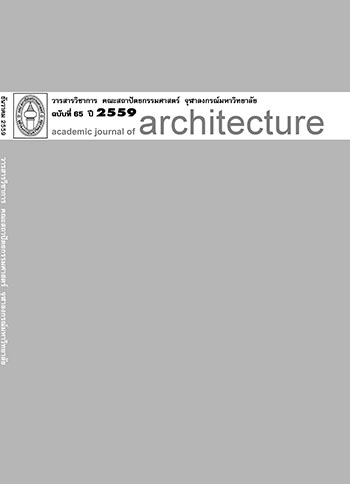Ventilation Ventilation Effectiveness of Door-sided Operable Shutter (Air Post) in High-rise Residential Building
Main Article Content
Abstract
High-rise residential buildings in the city are typically designed without taking serious consideration of natural ventilation. The reasons behind this are the limited size of lands, small-size living units, small window exposures, no shading for sun and rain, and poor thermal performance of the envelope. The results are the excessive accumulation of solar heat gain through unprotected glazed windows thus causing the “Green House Effect’ and humidity buildup in the bathrooms as the residents leave for work after taking a bath in the morning. In addition, residents do not prefer to leave windows open for ventilation during daytime for fear of rain. That makes the matters worse as the solar heat has caused the inside to be warm up until the evening when the residents come back and need to turn on air-conditioners at full power. There is an idea to bring natural ventilation to use in high-rise residential buildings more effectively for thermal comfort and good indoor air quality. The design team has developed ‘Air Post’, a Door-sided Operable Shutter installed at the entry of every living unit in order to allow natural ventilation from the units to corridors. Air Post is simply a metal mailbox put along the height of the door; however, the lower half of the box is equipped with metal shutters of which the resident can open or close the lid from the inside. By using Air Post, the resident can enjoy natural ventilation at night or when the air-conditioner is off as the outside weather is comfortable. Even during the day when nobody is inside, Air Post can be opened in order to help ventilating the warm and humid air out of the room.
To ensure that Air Post can successfully enhance thermal comfort and indoor air quality, the developer team then needed to perform a test for air exchange and ventilation effectiveness using a Blower Door method based on the ASTM E779-03: Standard Test Method for Determining Air Leakage Rate by Fan Pressurization. The test showed that Air Post can help increase the ventilation rate by 37%. The air exchange rate increases from 1.73 ACH to 2.38 ACH. The successful test results have brought Air Post to be in use for every high-rise residential condominium in the future.
Article Details
References
คำรน สุทธิ. “ผลกระทบของการรั่วซึมของอากาศต่อผลการใช้พลังงานในระบบปรับอากาศของเรือนไทยและบ้านร่วมสมัย.” วิทยานิพนธ์ปริญญามหาบัณฑิต คณะสถาปัตยกรรมศาสตร์ จุฬาลงกรณ์มหาวิทยาลัย, 2554.
ดนุสรณ์ บัวขจร. “การพัฒนาวิธีการประเมินค่าการถ่ายเทความร้อนรวมและการใช้พลังงานรวมของอาคารชุดพักอาศัยในกรุงเทพมหานคร.” วิทยานิพนธ์ปริญญามหาบัณฑิต คณะสถาปัตยกรรมศาสตร์ จุฬาลงกรณ์มหาวิทยาลัย, 2554.
ประวิตร กิติชาญธีระ. “ประสิทธิภาพการประหยัดพลังงานของอุปกรณ์กันแดดแบบผนัง 2 ชั้น กรณีศึกษาอาคารพักอาศัยในกรุงเทพมหานคร.” วิทยานิพนธ์ปริญญามหาบัณฑิต คณะสถาปัตยกรรมศาสตร์ จุฬาลงกรณ์มหาวิทยาลัย, 2553.
มณีนาถ ลินวัฒนา และอรรจน์ เศรษฐบุตร. “แนวทางการออกแบบช่องเปิดประเภทเกล็ดระบายอากาศ เพื่อลดการใช้พลังงาน สำหรับอาคารชุดพักอาศัยแบบผังทางเดินร่วม.” เอกสารประกอบการประชุมวิชาการเครือข่ายพลังงานแห่งประเทศไทยครั้งที่ 12 ณ โรงแรมวังจันทน์ ริเวอร์วิว จ.พิษณุโลก, 8 - 10 มิถุนายน 2559.
สริน พินิจ. “การระบายอากาศโดยธรรมชาติ แนวทางการออกแบบปรับปรุงผังอาคารชุดพักอาศัย: กรณีศึกษาโครงการบ้านเอื้ออาทร.” วิทยานิพนธ์ปริญญามหาบัณฑิต คณะสถาปัตยกรรมศาสตร์ จุฬาลงกรณ์มหาวิทยาลัย, 2553.
อภิญญา บุญมา. “ผลกระทบจากการกำหนดค่าการใช้พลังงานรวมของอาคารตามกฎหมายที่มีต่อการออกแบบคอนโดมิเนียม.” วิทยานิพนธ์ปริญญามหาบัณฑิต คณะสถาปัตยกรรมศาสตร์ จุฬาลงกรณ์มหาวิทยาลัย, 2555.
อรรจน์ เศรษฐบุตร. “การพัฒนาเกณฑ์ขั้นต่ำของคุณสมบัติการป้องกันความร้อนของเปลือกอาคารในอาคารทาวน์เฮ้าส์.” JARS 5, 1 (2007): 29-51.
อรรจน์ เศรษฐบุตร และ ธนิต จินดาวณิค. “การพัฒนาเกณฑ์ขั้นต่ำของคุณสมบัติการป้องกันความร้อนของเปลือกอาคารในอาคารบ้านเดี่ยว.” เอกสารประกอบการประชุมเชิงวิชาการเครือข่ายพลังงานแห่งประเทศไทยครั้งที่ 3 โรงแรมใบหยกสกาย กรุงเทพฯ, 23-25 พฤษภาคม 2550.
ASTM. Standard Test Method for Determining Air Leakage Rate by Fan Pressurization; ASTM E779-03. West Conshohocken, PA.: American Society for Testing and Materials, 2003.
Kootin-Sanwu, V., Sreshthaputra, A., and Haberl, J. “Short-term Monitoring to Diagnose Comfort Problems in a Residence in Central Texas.” Proceeding of the Twelfth Symposium on Improving Building Systems in Hot and Humid Climates, College Station, Texas, Texas A&M University, May 15-17, 2000.
Sherman, M. “Estimation of Infiltration from Leakage and Climate Indicators.” Energy and Buildings 10, 1 (February 1987): 81–86.
Sreshthaputra, A., Haberl, J., and Andrews, M.J. “Improving Building Design and Operation of a Thai Buddhist Temple Using Transient Coupled DOE-2/CFD Simulations.” Energy and Buildings 36, 6 (June 2004) : 481-494.


